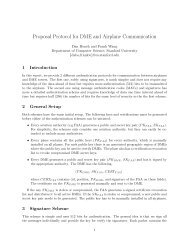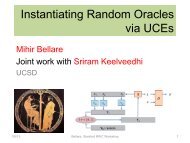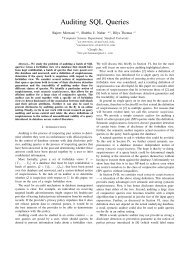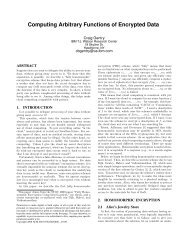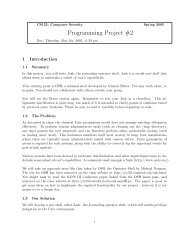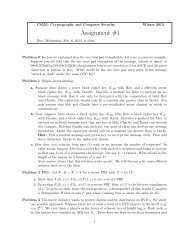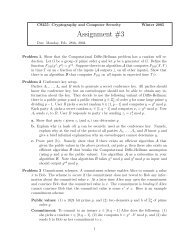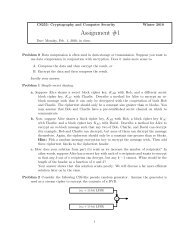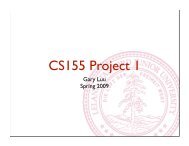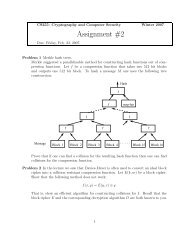Assignment #1: Solutions - Stanford Crypto Group
Assignment #1: Solutions - Stanford Crypto Group
Assignment #1: Solutions - Stanford Crypto Group
Create successful ePaper yourself
Turn your PDF publications into a flip-book with our unique Google optimized e-Paper software.
Answer 2. (a) Consider an adversary that makes a single query to the challenger at the point 0, obtaining<br />
some string y, and outputs 1 if the first bit of y equals the (|y|/2 + 1) th bit of y, and outputs 0 otherwise.<br />
Now, in the real world, the adversary receives y = F1(k,0) = F(k,0)||F(k,0), and so the two selected bits will<br />
always match, and the adversary will always output 1. In the ideal world, the adversary receives y = R(0), a<br />
uniformly random string, and the two selected bits will match with probability 1/2. Thus, the adversary has<br />
advantage |1 − 1/2| = 1/2, which is nonnegligible.<br />
(b) Suppose there is an adversary A that breaks F2. We will construct an adversary B to break F. Our<br />
adversary B runs A internally, and for each of its queries x, submits x ⊕ 1 n to the challenger, and returns the<br />
result to A. When A terminates, B then outputs whatever bit A outputs. Now, when B faces the real-world<br />
challenger, A sees F(k,x⊕1 n ) = F2(k,x); while when B faces the ideal-world challenger, A still sees a fresh<br />
uniformly random string for each distinct query, matching its view in the PRF security game for F2. Thus<br />
A, and hence B, must have nonnegligible advantage in distinguishing the two worlds, a contradiction since<br />
F is assumed to be a secure PRF.<br />
Answer 3. (a) Let nodes v1,...,vlog 2 n be the nodes along the path from the root of the tree to leaf<br />
node number r. Since the tree is binary every node vi for i = 2,...,log 2 n has exactly one sibling. Let<br />
u2,u3,...,ulog 2 n be the siblings of nodes v2,...,vlog 2 n. Let K2,...,Klog 2 n be the AES keys associated with<br />
the nodes u2,...,ulog 2 n. The header will contain the encryption of the content-key K under all keys K =<br />
{K2,...,Klog 2 n}. Clearly player number r cannot decrypt the movie since it does not have any of the keys<br />
in K. However, any other player t = r can decrypt the movie. To see this, consider the path from the root<br />
of the binary tree to leaf node t. Let u be the highest node along this path that does not appear on the path<br />
from the root to leaf node r. Then the key Ku associated with node u is in the set K (since the sibling of u is<br />
a on the path to r). Furthermore, player t contains the key Ku and it can therefore obtain the content-key and<br />
then the movie. Hence, player r cannot play the movie, but all other players can.<br />
(b) For i = 1,...,k let Ui be the set of consecutive leaves in the range [ri + 1,ri+1 − 1] (we are assuming<br />
r0 = 0 and rk+1 = n + 1). For an internal node v in the binary tree let Sv be the set of leaves in the subtree<br />
rooted at v. We say that a set of leaves Ui is exactly covered by internal nodes v1,...,vb if Ui = ∪b j=1Sv j . We<br />
show below that each set Ui can be exactly covered by a set of at most 2 · log2 n internal nodes. This means<br />
that to exactly cover all sets U0,...,Ur we need at most c = 2(r + 1)log2 n internal nodes. Let v1,...,vc<br />
be the internal nodes needed to cover all of U0,...,Ur. If we encrypt the content-key using the keys Kv<br />
associated with each of these nodes then all players other than those in R can recover the content-key while<br />
the players in R cannot. This shows that using header containing at most 2(r + 1)log2 n ciphertexts we can<br />
revoke all players in R without affective any of the other players.<br />
It remains to show that given a set of consecutive leaves U in some range [a,b] it is possible to exactly<br />
cover U using at most 2 · log2 n internal nodes. Let u1 be the highest node in the tree so that the subtree<br />
rooted at u1 has leaf a as its left most leaf. Let v1 be the highest node in the tree so that the subtree rooted at<br />
v1 has leaf b as its right most leaf. Now, for i = 2,...,log2 n define ui to be the right sibling of the parent of<br />
ui−1 (the right sibling of a node w is the node at the same height as w which is immediately on the right of<br />
w). Similarly, define vi to be the left sibling of the parent of vi−1. Let j be the smallest value so that u j = v j<br />
or that u j,vj are adjacent siblings in the tree. Then it is easy to see that u1,...,uj,vj,...,v1 is an exact cover<br />
of [a,b]. This covering set contains at most 2 · log2 n nodes as required.<br />
2



